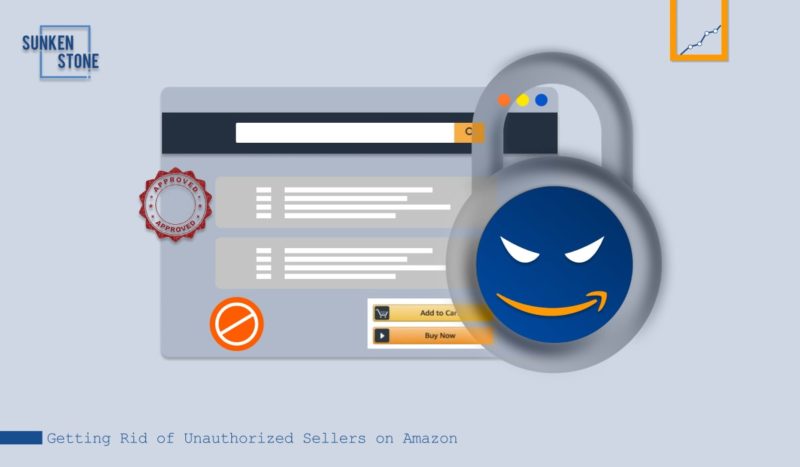
Bad actors in the Amazon ecosystem are a persistent problem for manufacturers, brand owners, and authorized sellers on Amazon. These bad actors create phony listings using fake names or multiple accounts to steal sales from legitimate sellers. Unauthorized sellers often lower their prices significantly to attract more customers, killing the profit margins of authorized sellers in the process.
Even worse, they sometimes sell counterfeit products to maximize profits which can do significant damage to the reputations of legitimate sellers. In some instances, unauthorized sellers even manipulate Amazon’s algorithm to gain an unfair advantage over legitimate ones.
In this article we’ll walk through why the problem of unauthorized sellers on Amazon is such a serious one, how bad actors game the system, and, most importantly, what legitimate sellers can do to fight back to protect their sales and reputations.
How unauthorized sellers operate
There are a number of tactics unauthorized sellers use in order to game the system. It’s helpful
to understand what these are before diving deeper into solutions.
- Underselling – Many unauthorized sellers source products from manufacturers at discounted prices. This allows them to undercut other sellers on price in a bid to win the Buy Box. This tactic is often successful, pushing unauthorized sellers into the coveted position. These sellers may also use automated pricing software to ensure lower prices.
- Using fake ASINs and company identities – Unauthorized sellers often create fake ASINs for each of the products they want to list. It becomes very difficult to track them in these cases, even with the benefit of price tracking software at your disposal.
Sellers also use phony names instead of their real brand names to conceal their identities. When legitimate sellers do manage to identify and track down bad actors these sellers simply switch to a different seller account and carry on as “new Amazon seller”. - Inaccurate product information – Unauthorized sellers may copy the product listings of legitimate sellers and then tweak product copy to make their offering look more desirable to customers. This can involve adding inaccurate product specifications to give a false impression that their products are better, essentially tricking buyers into believing the product they’re buying is superior to the legitimate offering.
- Copycatting – Unauthorized sellers also ride on the reputation of successful brands on Amazon to lure customers from legitimate sellers. They may create or purchase knockoffs and sell your products to unsuspecting customers who believe they’re receiving the real thing. Since unscrupulous sellers are always cutting corners to make quick profits, these counterfeit products can do serious damage to the reputation of legitimate brands.
Why Bad Actors Try to Game The System
The simplest answer to this question is that the Amazon ecosystem is massive and its sheer size makes it relatively easy for unauthorized sellers to turn a quick profit. With more than 2.5 million sellers on the marketplace, it is difficult for authorized sellers to identify the bad actors selling their products without permission.
Further, the scale of the opportunity to make money (albeit illicitly) offers a strong incentive for bad actors to try to take advantage.
Unauthorized sellers, who care only about short term gains as opposed to long term customer relationships, are happy to cut corners to make quick profits at the expense of legitimate sellers.
Because they often obtain their products through illegitimate means, they can afford to sell at significantly lower prices.

Retailers are acutely aware of the damage unauthorized sellers can do to their brands and, ultimately, to their bottom lines, eroding brand reputation, creating a race to the bottom on prices, and commoditizing products.
But surely if unauthorized selling is such a problem then Amazon must be actively working on solutions, right?
Unfortunately not.
Amazon is overwhelmingly unconcerned with the issue of unauthorized sellers. It’s clear that their main concern is for their bottom line and competitive pricing – even when it’s the result of unscrupulous behavior – is good for that bottom line because it draws more customers to the platform.
Amazon does have a policy that requires all sellers on the marketplace to offer authentic products. The sale of counterfeit products is prohibited and any seller who violates this policy can suffer consequences. If there are unauthorized sellers who are violating your intellectual property rights, you can report them to Amazon and they will take action against those sellers.
However, Amazon’s policies don’t explicitly prohibit unauthorized selling of authentic products that do not infringe on copyright or trademark, which has allowed unauthorized selling to proliferate.
Even when it comes to MAP pricing violations, Amazon maintains that these agreements are made between brands and resellers and they will decline to get involved in such disputes.
In recent years some brands have elected to opt out of Amazon citing frustrations from unauthorized sellers. Renowned brands such as IKEA, Nike, Birkenstock, and PopSockets have left Amazon because of issues to do with underselling by resellers.
3 Strategies To Stop Unauthorized Sellers On Amazon
Even though Amazon itself is mostly uninterested in solving the problem of unauthorized selling, retailers can’t afford to ignore the issue and hope it never affects them. Unauthorized selling is rife on the platform and it’s up to authorized sellers to leverage the best strategies to stop unauthorized sellers from hurting their business.
Amazon’s massive scale allows unauthorized sellers to count on being able to avoid detection by original manufacturers, however there are 3 specific things brands can do to fight back:
#1: Sign Up For Amazon Brand Registry
One of the easiest ways to remove unauthorized sellers on Amazon is to sign up for Amazon Brand Registry, whereby you’ll have greater control over your brand’s product listing.
Brand registered sellers enjoy additional protections across the marketplace and being a brand
registered seller unlocks enhanced monitoring and enforcement tools on Amazon. Although this tactic may not entirely prevent bad actors from selling your products without your permission, it will give you greater influence and control.
#2: Register As A Restricted Brand On Amazon
A restricted brand cannot be sold on Amazon without going through an approval process. That means by registering as a restricted brand on Amazon, third-party sellers must seek your approval before selling your products. Brands can choose to restrict as many products as they wish.
To become a restricted brand on Amazon, you’ll be required to contact Seller Support and ask Amazon to enroll your brand in this category.
#3: Look for a 3rd Party Solution
If all of this sounds like a heavy burden on sellers, it is. Using a 3rd party solution like Emplicit is a great option for brands who want to take the power back from unauthorized sellers but don’t have the time or expertise to manage the process themselves. Emplicit can monitor cases and resolve them directly with Amazon and/or resellers on your behalf, offering a proactive means of safeguarding your brand.
Combined, these tactics can help keep unauthorized sellers at bay and protect your reputation, revenue, and existing customers.
Don’t Let Your Brand Fall Prey To Unauthorized Sellers
If the actions of unauthorized sellers are threatening your brand’s value and reputation, reach out to Emplicit today to find out about our customized solutions. We are a premier, results- driven Amazon marketing agency for growing eCommerce brands. The experts at Emplicit will help monitor your brand 24/7/365 and employ the best strategies to stop unauthorized resellers.

